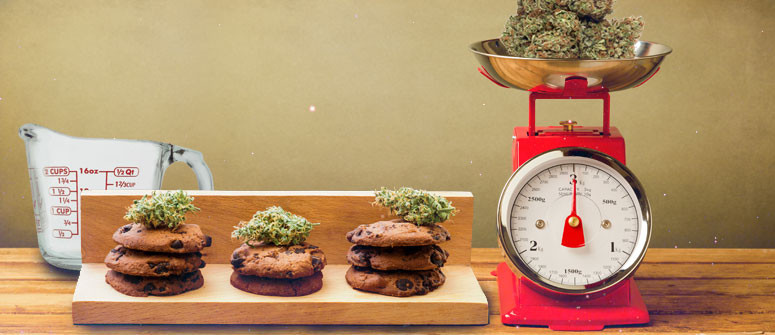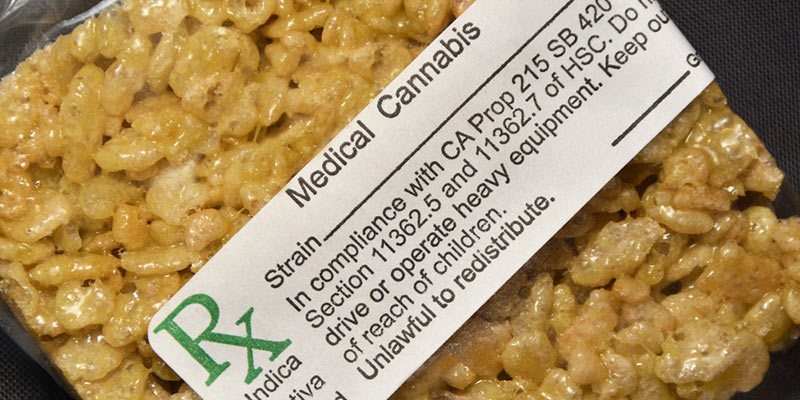

Explore blog topicsGrowLifestyle & CultureCannabis 101CBDHow ToReviewsScienceHealthPolitics
Last updated June 18-2020 Published April 18-2017
Edibles are extremely popular. However, most people are familiar with some kind of horror story involving someone who gobbled down too many pot brownies and ended up passing out and/or puking.
Unfortunately, controlling your dose with edibles can be difficult (especially when making them at home) and too much of a good thing can be really unpleasant.
In this article, we explore some basic tips to help you get the right dosage with your cannabis edibles.
DOSING WITH A STORE-BOUGHT EDIBLE

Opinions towards cannabis are changing, and many places around the world are leaving behind old prohibitionist policies on weed in favor of creating structured, legal markets.
Luckily, with legalization also comes standardization, and many of the areas with legal marijuana markets (such as Colorado, California, and Washington in the US) are working hard to create strict laws governing the potency and quality of the weed available both for recreational and medical sales.
In Washington, for example, all cannabis products available through licensed retail outlets are clearly labeled with the total THC percentage, and edibles come in serving sizes of maximum 10 milligrams.
In Colorado, a dose of THC also amounts to 10 milligrams, and most edibles come in single dose servings.
If you’re lucky enough to live in one of these areas, managing your dosage is much simpler than if you’re making edibles at home.
Simply read the package of your edible carefully to double-check how many milligrams or doses in a serving. Then, we recommend taking half of that serving, waiting roughly 1 hour, and then taking more if necessary.
This allows you to avoid “overdosing”, which can be especially unpleasant when using edibles as the effects are harder to manage.
When you smoke or vaporize cannabis, the THC and other cannabinoids in the weed are absorbed into your blood through your lungs. This process is extremely fast, and you’ll usually feel the effects of the THC in your weed kick in almost instantly.
This means that if you feel the effects of your weed coming on too strong, you can usually put down your joint, bong, or vaporizer and you’ll usually feel better pretty soon.
However, things are different with edibles.
When you ingest a cannabis edible, however, the THC and other cannabinoids enter your bloodstream through the digestive tract. It can take up to 45 minutes to 1 hour for your body to digest an edible and for you to feel the effects of the edible.
This means that if you happen to consume too much of an edible, you’re usually in for a long journey that can seem overwhelming and unpleasant.
By taking half a dose, assessing how you feel in roughly 45 mins to 1 hr, and then taking the rest of your dose if necessary, you minimize your chances of “overdosing” with edibles.
DOSING WITH A HOMEMADE EDIBLE
If you’re using homemade cannabis edibles, dosing accurately is a lot more difficult, but not impossible. Below we’ll share a reliable method for calculating how much THC is in your homemade edibles and how to adjust your dosage accordingly.
Dosage will vary greatly depending on the cannabinoid profile of the weed you use. Strains today can contain anywhere from 10-20+% THC. Always try to inform yourself about the strain you're using and it’s unique cannabinoid profile. Most of this information is available online, although it should be taken with at least a few grains of salt.
If you live in an area where you can legally buy cannabis, the store you bought it from should be able to give you exact information about the cannabinoid profile of your weed.
If you cannot find any reliable information online about your strain, we recommend assuming it has roughly 15% THC. For the sake of this article, we’re going to assume you’re using weed with 15% THC.
Given these numbers, it’s reasonable to assume that every gram of weed (or 1000mg) contains roughly 150 mg of THC.
Now, take the amount of ground cannabis used in your recipe and divide it by the overall yield of what you're cooking.
So, when following a cannabutter recipe that requires 500 grams of butter and 20 grams of weed (15% THC), you’re essentially making 500 grams of butter with a total THC content of 3000 mg (20 grams x 150mg). In that case, every gram of butter will contain roughly 6 mg of THC (just over half of an average dosage).